Questar Distribution
![]() News
News ![]() Notes & Interesting Articles
Notes & Interesting Articles ![]() Overview
Overview ![]() Pricing
Pricing ![]() Products
Products ![]() Service or Repair
Service or Repair
Questar Telescopes ![]() LD Surveillance Systems
LD Surveillance Systems ![]() LD Microscopes
LD Microscopes ![]() Accessories
Accessories


QUESTAR 7 MODELS
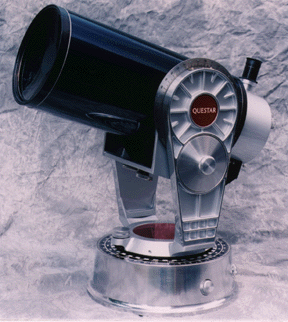 Above: Original Questar Seven barrel shown here mounted on the optional Fork Mount Base displayed at Company Seven (69,203 bytes). |
-
The original Questar 7 telescope was introduced in 1967, with the first optics set being completed for Questar on 26 January 1967, Serial No. P-7-1 at manufacturing facilities nearby Company Seven in Maryland. These are limited production handcrafted instruments, with production over time averaging about 25 instruments per year. Most Seven's sold have been delivered to government and industry for uses including surveillance, research, and astronomy. Ruggedized models have been flown by intelligence and research agencies. You may not have realized it but you probably have seen images shot through the Seven and its cousins at the cinema, of launches at Kennedy Space Center, Space Shuttle landings at Edwards Air Force Base, and an ascent of Mount Everest. One of the more recent declassified success stories involved high resolution images taken by a Step Zoom 180 instrument (a surveillance oriented, automated variant of the Questar 7) of Iraqi SCUD missile launchers from a distance of 35 kilometers - when presented to the United Nations these images strengthened the case to launch "Desert Storm" operations. But increasingly, the more demanding amateurs are buying these too.
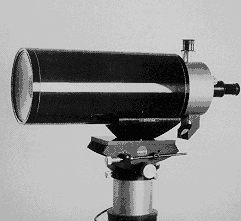 It would be difficult to find any other production telescope that has the combination of compact mechanical precision and efficiency, with optical performance and durability which these instruments afford at similar cost. The optical design is based on a Caprellian designed 7 inch (178mm) aperture Maksutov Cassegrain telescope with a nominal 2,413mm focal length. The optics are hand figured and aspherized as a matched set at a facility nearby Company Seven that has been making optics for the Questar Corporation since the 1954. Since these instruments are represented as offering a high standard of excellence and they are priced accordingly, we hold these to a commensurate standard of excellence. Questar does not publish or promise any degree of optical accuracy, though most of these systems should satisfy the more demanding applications. But for examples of 1999 qualities consider two instruments that we delivered then; one tested on a professional interferometer as 1/6 wave peak to valley with a smooth 1/20th wave RMS, while the other 1/4 wave PV and a very smooth 1/30th RMS with a Strehl ratio of 96.5%. These are quite acceptable for systems of this aperture, and a good achievement for aspheric systems. Keep in mind that about the best 7 system made in 1999 tested at about 1/6.5 wave PV and 1/52 wave RMS - this tested with the optics installed into the mechanical barrel assembly!
It would be difficult to find any other production telescope that has the combination of compact mechanical precision and efficiency, with optical performance and durability which these instruments afford at similar cost. The optical design is based on a Caprellian designed 7 inch (178mm) aperture Maksutov Cassegrain telescope with a nominal 2,413mm focal length. The optics are hand figured and aspherized as a matched set at a facility nearby Company Seven that has been making optics for the Questar Corporation since the 1954. Since these instruments are represented as offering a high standard of excellence and they are priced accordingly, we hold these to a commensurate standard of excellence. Questar does not publish or promise any degree of optical accuracy, though most of these systems should satisfy the more demanding applications. But for examples of 1999 qualities consider two instruments that we delivered then; one tested on a professional interferometer as 1/6 wave peak to valley with a smooth 1/20th wave RMS, while the other 1/4 wave PV and a very smooth 1/30th RMS with a Strehl ratio of 96.5%. These are quite acceptable for systems of this aperture, and a good achievement for aspheric systems. Keep in mind that about the best 7 system made in 1999 tested at about 1/6.5 wave PV and 1/52 wave RMS - this tested with the optics installed into the mechanical barrel assembly!
Left: an original Questar Seven Barrel shown mounted onto an optional pier, with optional 1.25 inch diameter Image Erecting Axial Prism (11,141 bytes)
The construction is of professional industrial quality made entirely of precisely machined aluminum, stainless steel, phosphor bronze, etc. materials. In 2002 new technologies were incorporated providing lighter weight and improved acclimatization. Optional ruggedized tube construction in thermally stable Invar or with aluminum are available options.
- Dielectric Coatings: a very high-tech dielectric coating that was developed originally for military optics used in hostile environments such as blowing desert sand. There is no aluminum or other reflective metal used. The reflective surface consists of 52 layers of thin film oxides, similar to those used in antireflection coatings. The coatings are deposited by an electron beam evaporator at a high temperature.
- Reflectivity: above 99% over the entire 4000 to 7000 photo-visual range. Thin film coatings have
extremely low surface scatter compared to aluminum or enhanced aluminum coatings; examination with a laser source shows approximately a five fold reduction of surface scatter over conventional coatings.
- Durability: the coating is extremely durable compared to metal coatings and can be cleaned repeatedly.
- Brass Locking Ring: Our customers have appreciated the non-marring benefit of the brass locking ring on our telescope reducing adapters, and on our 2 inch diameter Astro-Physics Barlow; they have urged have urged development of a diagonal with this feature. The recessed brass ring is under the thumbscrew location so as you tighten the thumbscrew, the brass locking ring clamps around your eyepiece. This provides a more secure grip for your expensive eyepieces than the head of a single screw can provide. As an added advantage, the brass will not mar or score the surface of your accessories as simpler set screws
do.
- Baffled Flat Black Interior: The interior is fully antireflection machine threaded and then finished with a low reflection coating reduce any possibility of undesired internal reflection that might be visible in the form of ghosting. This helps to allow maximal light transmission.
- Threaded for 48mm Filters: If you thread your filters directly into the field barrel of the diagonal or our 2 inch to 1.25 inch reducer, then you can change eyepieces with ease without handling the filter. Furthermore, one standard size of filter becomes use able with almost every one of our visual and photographic accessories.
- Design Type: Maksutov Cassegrain
- Clear Aperture: 178 mm (7 inches)
- Nominal Focal Length: 2400mm (94.49 inches) at f13.5 (T16.6)
- Optional Effective Focal Lengths: 635mm, 900 mm, 1450 mm, 4000 mm, or 6000 mm (for a 9:45 to 1 zoom ratio!)
- Corrector: BK 7, Magnesium fluoride AR coated. Weight 2.4 lbs.
- Standard Primary Mirror: Pyrex aluminum coated, SiO over coated. Weight 2.6 lbs.
- Standard Secondary Mirror: Aluminum coated, on R2 of Corrector Lens
- Resolution: 0.7 arc seconds
- Nominal Backfocus: 151mm (5.94 inches)
- Format: Diffraction limited 18 mm @ 2400 mm EFL
Options Include:
- Camera Adapters for CCD, 35mm and Medium Format Film Cameras
- Eyepieces to vary magnification
- Filters: Color, Polarizing, Light Pollution Rejection, White Light Solar, Hydrogen Alpha
- Front Lens Protective Optical Flat Window, AR Coated
- Fused Silica Corrector (for extended sensitivity into the Ultraviolet)
- Fused Silica Primary Mirror
- Zerodur Primary Mirror
- Alt-Azimuth or Equatorial Mount Head with Tripod or Pier
- High Transmission "Broad Band" Coatings
- Special Purpose Filters
- Ultra lightweight composite mechanical construction.
- Positive and Negative Lenses to Vary Effective Focal Length
- Additional Finder/Guidescope Platform at 11 o'clock (on Seven Astro only)
- Mounting hardware: Quick Release or conventional Mounting Rings
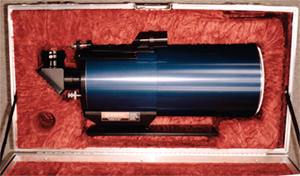
- Company Seven offers custom made ATA Transport/Shipping Case for the Questar 7, its mounts and accessories. The case provided by Questar with each optical tube assembly is a reasonable balance of economy and performance for routine storage of a telescope in a temperature and humidity controlled environment. However, if you plan for long term storage, or if you intend to ship the telescope or a mount by commercial carrier or transport it as check in baggage on an airliner (observing oversize and overweight restrictions) then your peace of mind and telescope will both be better served with a custom engineered solution - an ATA case by Company Seven.
Right: Questar Seven Astro barrel (right side shown) with optional Mounting Plate attached in optional Company Seven ATA Case (63,146 bytes).
Available Effective Focal Lengths:
Focal Length Focal Ratio T Stop 635mm f3.6 T4.4 1000mm f5.6 T6.9 1800mm f10.1 T12.3 4800mm f27.0 T33.2 6000mm f33.7 T41.4
![]() The original Questar 7 (replaced in Fall 2002 by the Questar 7 LW Titanium)
The original Questar 7 (replaced in Fall 2002 by the Questar 7 LW Titanium)
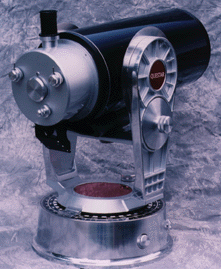 Left: original Questar Seven barrel on optional Fork Mount showing Control Box with controls of Finder/Telescope view, Focus, Barlow Lens, Solar Filter for Finder (48,105 bytes). |
The Questar 7 is a versatile high resolution optical tube assembly which combines the light weight and great portability of the Maksutov-Cassegrain. The Questar Seven telescopes are often compared in terms of durability, freedom from maintenance, resolution, and their apochromatic color correction to the most perfect six or seven inch aperture apochromatic refractors. The Questar 7 is similar in light gathering (actual transmission) to about a 6 inch Apo refractor, and have resolution about that of a 7 inch Apo. With high transmission coatings, the Questar 7 telescope has more light throughput (about 520 times the light gathering power of the unaided human eye) than a high quality 15cm apochromat refractor (of about 475). When the telescope is equipped with a TeleVue 55mm Plossl ocular (50 degree apparent field of view, and field stop of 46.0mm) this permits fields of view of up to 1.09 degrees wide at 44X (with a 4.1mm diameter exit pupil). The instrument can be operated at magnifications high enough to surpass the common "seeing" limits (turbulence) set by the atmosphere; a bicycle spoke two miles distant could be resolved on a steady day. Photographs clearly reveal small nameplates in the grill of an automobile more than two miles distant across a bay in the shadows of a parking garage. The Questar 7 resolution approaches that of our best 180mm apochromatic refractors - all perfectly suited for high resolution observing of the moon, planets, Sun, or the brighter deep sky objects. Stars will appear as pinpoint diamonds against a black velour background; colors of many stars are clearly revealed. Subtle features in the bands of Jupiter are obvious, the Cassini Division (and the "A Ring") on Saturn are obvious when the tilt of the rings is favorable.
The best very Apos such as our Astro-Physics are more versatile yet can not be as portable as a similar aperture Maksutov-Cassegrain, nor are they readily available (a several year wait is common) so then the Questar Seven satisfies many and serves those (particularly in the Suburbs) with a limited interest in seeing the most faint objects or where an extreme wide field of view is not so critical a concern. These systems permit one to concentrate on the planets, moon, sun or, where portability or travel is a crucial element to their success.
When mated to the optional Questar 7 Fork Mount, or onto an optional third party German Equatorial mount then it has the fully instrumented astronomical features and tracking capabilities required of an astronomical telescope. The OTA of the Questar 7 may be attached onto the Questar Fork Mount in such a manner to facilitate the easy disjoining of optical tube from the mount. The shift from one configuration to the other is accomplished by the use of a special fork mount Saddle, which adds very little to the weight of the instrument but permits the quick detachment of OTA from the base of the fork mount with a single knurled bolt - no tools are needed to do this. The result is an instrument of unique flexibility, perfect for the multiple interests of a whole family of users. The Mounting Base of the Questar 7 is threaded to accept the common 1/4"-20 tpi, and 3/8" mounting bolts and so it is a simple matter to attach the OTA onto a variety of tripods, heads, or other fixturing hardware. In addition we provide a registration position to help insure the proper realignment of the telescope to the fork when it is reinstalled onto the Questar Fork Mount.
The Questar Fork Mount is a stunning piece of craftsmanship made of a brushed cast aluminum, parts of which are lacquer painted. Each of both axes incorporates a manual friction drive control, the Right Ascension also having slip clutch permitting manual override of the tracking motor. The fork mount as originally sold included an AC powered synchronous clock drive motor. The motor drives the telescope fork and the Right Ascension setting circle. A Declination setting circle with declination motion variable clutch lock is also provided. An AC powered single axis drive corrector was made to permit operation of the telescope from wall current, and to provide a means to make slight adjustments to the tracking. By the late 1980's the Powerguide I became available, and this option permitted world wide operation of the telescope from a replaceable 9 volt DC battery housed in the base. The Powerguide systems incorporate a drive corrector to vary tracking rates and make fine positioning adjustments; this was optional when originally introduced but since the reintroduction of the Fork Mount in 2002 the Powerguide II has been included as standard equipment. The optional Questar Seven Motorized Declination Drive controlled by the Powerguide II permits remote control of that axis too. The drive is smooth enough to provide flawless tracking of celestial objects for visual applications, although the telescope can easily be accessorized to introduce one into most types of film or CCD astrophotography.
Your Questar 7 can be well served with a selection of precision Equatorial mounts such as our computer controlled Astro-Physics Astro-Physics German equatorial mountings, or our Losmandy Model G-11 German equatorial mountings. Some suitable German Mounts may be less costly and massive as that necessary to support a longer refracting telescope that would offer similar visual performance.
For photography at Prime Focus the telescope can show a field of view of 0.83 x .57 x 1.0 degrees on the common 35mm format. It can support a variety of optional 35mm and medium format film cameras, or a wide selection of night vision electro optic systems, astronomical CCD imaging/autoguide cameras which can render invisible objects obvious even from suburban settings. The quality of CCD images taken by the Questar (as those made with the best Apo refractors) are so good, that relatively little image processing is necessary to produce satisfactory images. With any of a number of optional telecompressors the Questar 7 can operate as fast as 635mm showing 0.8 x 0.6 x 1 degree at f3.5 on a common 2/3 inch diagonal CCD camera.
Original Classic 7 Barrel Arrangement:
The Classic 7 Barrel telescope is similar to the smaller Questar 3-1/2 Standard telescope in that they both incorporate the Questar "Control Box" at the rear of the telescope. The control box provides two viewing ports (Axial or Visual Port), control levers with linkages providing quick flick knob selection. This arrangement permits the selection of any one of three magnification (power) changes per 1.25" diameter eyepiece: 1. an internal finder, 2. low magnification at Prime Focus, and 3. high magnification. Included features also include a star-diagonal prism to make observing of objects overhead more comfortable, a solar filter for finder lens, off-axis glass solar filter for the telescope objective (full aperture filter optional), and focus able eyepiece diopter adjustment to permit most persons to focus the integral finder. The telescope barrel rotates within its mount to provide viewing height or position adjustments - again for improved comfort and convenience.
The Classic 7 included: Questar 7 Maksutov-Cassegrain Optical tube assembly with precision thread-on anodized aluminum lens cover, choice of two 1.25 inch diameter Questar Brandon oculars. Control Box with integral finder, dial-in integral Barlow lens (typically between 1.6X to 2.1X), precision integral Zenith prism providing upright, reversed views at standard eyepiece position, Axial Photo-visual Port, Basic Camera Coupling Set (camera "P" Ring optional). Mounting Collar. The barrel stores into a furnished foam lined carrying case, machined thread on Lens Cover.
Weight of Barrel: 22 lbs., in airline transport approved case 42 lbs, shipping weight about 72 lbs.
![]() For dimensions and a construction overview of the original Seven Classic 7 telescope sold by Company Seven download the illustrated two page brochure from Company Seven's Library. Download size is 1,284,506 bytes (in Adobe ".pdf" format).
For dimensions and a construction overview of the original Seven Classic 7 telescope sold by Company Seven download the illustrated two page brochure from Company Seven's Library. Download size is 1,284,506 bytes (in Adobe ".pdf" format).
You may also find it interesting to read our article on the restoration of a Questar 7 with Fork Mount: "Questar Seven S/N P-7-378-DP: A Restoration Mini-Epic!" for Company Seven's Museum Collection.
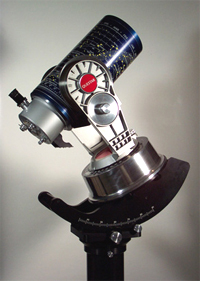 While the basic Questar 7 barrel had not changed since much since its introduction in the 1960's, over recent years Company Seven and Questar had been aware of developments involving materials and manufacturing technologies and we had hoped to incorporate lessons learned and other improvements into a refined Questar 7. The dramatic advances that would become incorporated to produce the Questar Classic 7 LW happened in no small measure due the acquisition of Questar in 2001 by an experienced, aerospace quality manufacturer.
While the basic Questar 7 barrel had not changed since much since its introduction in the 1960's, over recent years Company Seven and Questar had been aware of developments involving materials and manufacturing technologies and we had hoped to incorporate lessons learned and other improvements into a refined Questar 7. The dramatic advances that would become incorporated to produce the Questar Classic 7 LW happened in no small measure due the acquisition of Questar in 2001 by an experienced, aerospace quality manufacturer.
The Questar Classic 7 LW evolves from the original "Classic 7" design. The LW model incorporates lighter weight materials, and engineering features to provide improved thermal acclimating characteristics than its predecessor.
The Control Box too has been redesigned, it can now accept eyepieces of not only 1.25 inch but will also accept up to two inch (2") diameter oculars. However, due to the aperture restriction imposed by having to install a thread-on Eyepiece Holder onto a curved surface, there is little practical advantage to this development. The Classic 7 LW Titanium can not take full advantage of the 46mm diameter field stop of the widest field of view oculars showing up to 1.1 degree actual field of view (as provided by our optional TeleVue 55mm Plossl or 41mm Panoptic eyepieces). Instead the aperture restriction of the Questar Classic 7 LW limits the field of view to about 3/4 degree only marginally more than that which can be seen with a good 1.25" ocular. And so unless one is more concerned about Exit Pupil diameter than Field of View one will see little advantage in using 2" eyepieces of much lower than 26mm Focal Length. Those who seek the widest actual field of view possible with a Questar 7 should opt for the Questar Astro 7 model described below.
The Control Box of the Questar Classic 7 LW incorporates an brighter integral Finder, this is an improvement over those of the original Questar 7 telescopes.
And finally, in a stunning departure from prior 7's the Questar Classic 7 LW displays the Questar Star Chart on the Barrel with dark blue anodized Front and Rear Cells, and a Moon Map on the Dew Shield; these charts may be deleted from a new instrument order at no cost to the customer if so requested. This will be a matter of personal taste, it has no impact on performance. This model was announced to the public in September 2002, with deliveries commencing in January 2003.
Left: Questar Classic 7 LW Titanium on Optional Fork Mount and Pier (60,051 bytes). Click on image for enlarged view (64,113 bytes).
Control Box: The Classic 7 LW retains two viewing ports (Axial and Eyepiece Visual Port) with rotating control levers and linkages providing quick flick selection of where the light from the telescope or Finder is directed to. The Eyepiece Holder assembly incorporates the diopter adjustment mechanism, this permits most persons to dial the eyepiece in or out to achieve focus with the integral Finder. Within the Control Box is a ninety degree star-diagonal prism which can be dialed in to divert light from the telescope up to the visual Port, this makes observing of objects overhead more convenient. There is also a newly designed Barlow (negative) Lens which can be dialed into place to increase the magnification from the telescope by a factor of about 2X.
So the Control Box arrangement permits the selection of any one of three magnification (power) changes per eyepiece:
- 1. the internal finder,
2. low magnification at Prime Focus, and
3. high magnification.
The Finder of the Control Box also incorporates a dial in Solar Filter, while optional off axis or full aperture Questar glass solar filters for the telescope objective are among available options. The Classic 7 LW telescope barrel rotates within its mount to provide viewing height or position adjustments - again for improved comfort and convenience.
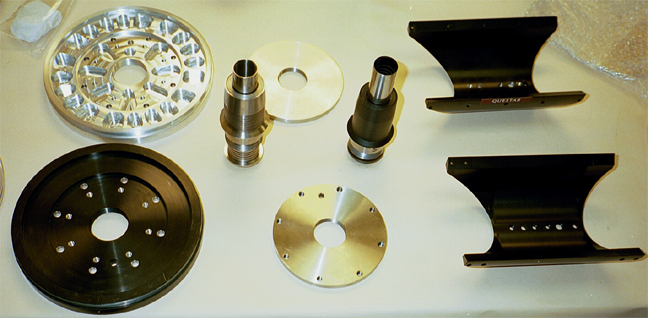
Above: Old Stainless Steel and New Titanium Components of Questar 7 (48,939 bytes).
Left to Right: Back Plate, Thimble/Primary Mirror Holder Assemblies, Mounting Bracket (186,930 bytes).
Click on image for enlarged view.
The Classic 7 LW includes: Questar 7 Maksutov-Cassegrain Optical tube assembly with precision thread-on anodized aluminum lens cover, Company Seven provides your choice of two 1.25 inch diameter Questar Brandon oculars (8mm, 12mm, 16mm, 24mm, or 32mm). Control Box with integral finder, dial-in integral Barlow lens, precision integral Zenith prism providing upright, reversed views at standard eyepiece position, Axial Photo-visual Port, Basic Camera Coupling Set (camera or video "P" Ring is optional). Finder Solar Filter, Mounting Collar. The barrel stores into an ABS foam lined wheeled carrying case with retracting handle. Company Seven offers optional deluxe custom fitted "Airline Transport Approved" cases to facilitate shipping the telescope world wide. Machined Lens Cover.
Weight of Barrel: 18 lbs., in airline transport approved case 38 lbs, shipping weight about 68 lbs.
![]() For current dimensions and a construction overview of the Seven Classic 7 LW Titanium telescope Questar 7 Classic LW Titanium download the illustrated two page brochure from Company Seven's Library. Download size is 175,927 bytes (in Acrobat Reader ".pdf" format).
For current dimensions and a construction overview of the Seven Classic 7 LW Titanium telescope Questar 7 Classic LW Titanium download the illustrated two page brochure from Company Seven's Library. Download size is 175,927 bytes (in Acrobat Reader ".pdf" format).
-
Considering the good economy, and the scarcity of premium quality mid aperture apochromatic refracting telescopes, the Questar Seven has enjoyed a resurgence in popularity even more so since the introduction of the lightweight, more versatile and compact variant: "Astro Seven" model. Company Seven can take some credit for helping over the years to persuade Questar to offer this version of the Questar 7, we contributed ides to the final product, and we continue to make minor improvements to those which are delivered by Company Seven.
The Astro Seven features the same optics, with similar quality focus mechanics, fit and finish as is furnished with the "Classic" Seven Barrel. However, in place of the Classic Seven Control Box (with it's 1.25 inch diameter focuser) is an Axial Port threaded to accept a variety of accessories including a new non marring 2 inch diameter "slip fit" fitting developed by Company Seven that receives the furnished two inch diameter mirror diagonal. The Astro 7 LW model (introduced in 2004) incorporates lighter weight materials, and engineering features shared with the Classic 7 LW Titanium to provide improved thermal acclimating characteristics than its predecessor.
The Astro 7 is the most versatile variant of the Questar 7. The Astro 7 does take full advantage of the 46mm diameter field stop of the widest field of view oculars showing up to 1.1 degree actual field of view when used with our TeleVue 55mm Plossl or 41mm Panoptic eyepieces. And so one does not have to compromise Exit Pupil diameter or Field of View. Those who seek the largest Exit Pupil diameter and widest actual field of view possible with a Questar 7 should choose the Questar Astro 7 model.
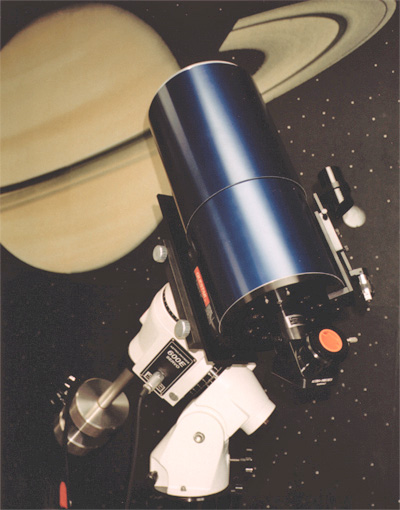 Above: Questar Seven Astro barrel (viewed from rear left) with Dewcap threaded onto stored position, attached to our optional Astro-Physics Model 600E GTO computer controlled German equatorial mount. Note the Axial Port with our Astro-Physics Maxbright 2 inch diagonal and 2 to 1.25 inch Reducer (in place of standard Questar diagonal), Starbeam sight top right on C7 designed bracket (123,818 bytes). |
And fitted to the Barrel at 10 or 2 o'clock positions is a high accuracy TeleVue "Star Beam" precision "red dot" sight with quick release mounting hardware. Company Seven thank Lenny for this has redesigned the mounting provision of the Starbeam so that the sight now rests on a bracket which extends from the rear of the telescope over the barrel, this new bracket has mounting holes to accept either the Starbeam sight, or an optional conventional finder for day and night use. Company Seven can provide a second bracket so that the customer may add a conventional refractive finderscope too.
This configuration of the Questar Astro Seven produces a much more compact, simpler, and lighter weight "carryon luggage" degree of portable optical tube assembly. Company Seven continues to work towards improvements in those special, premium products which we represent, and soon Company Seven intends to offer a reduced weight version of the Astro Seven, with the goal being to make it even more easily carried onto aircraft for international travel, and permit it to be employed on lighter weight mounts. To show our customers consideration, we will offer to perform these as retrofit able options. We do offer variants of this telescope for use in law enforcement, defense, and intelligence applications.
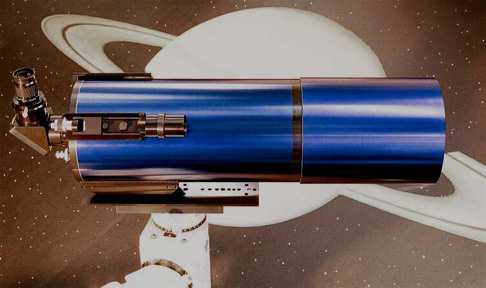
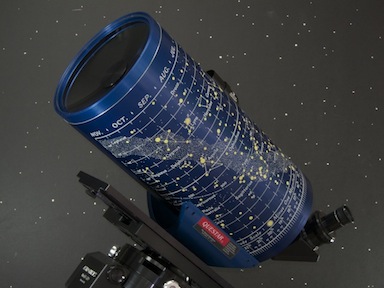
Above: at left is Questar Astro 7 Barrel with Dew Shield Extended, on optional Astro-Physics Model 600E GTO Mount (55,334 bytes).
To the right is Questar Astro 7 Barrel with optional Star Chart (37,824 bytes). Both instruments as displayed at Company Seven.
And finally, the Astro is more compact (18-3/4 long with Dew Shield stored and lens cover on) and weighs less than the original Classic 7, and about the same as the Classic 7 LW. The Astro 7 model resembles our surveillance "Ranger 7" but with the addition of a two inch diameter Mirror Diagonal (providing upright, reversed views at standard eyepiece position that with an optional 55mm ocular could show as much as 1.1 degrees of sky at 44X, with a 4.1mm exit pupil.
Left: "Questar Astro 7 barrel shown with optional Star Chart, on the optional Questar Fork Mount (72,261 bytes).
The Questar Astro 7 optical tube assembly includes Dew Shield, precision machined thread-on anodized aluminum lens cover (reverse and thread on to store), two inch diameter Mirror Diagonal, one 15mm or 20mm or 25mm Plossl ocular of 1.25" diameter, precisely machined "Star Beam" red dot sight with battery powered finder, extension tube set, Mounting Collar. The barrel stores into a furnished foam lined carrying case.
Weight of Barrel: 18 lbs., in standard carrying case 38 lbs, shipping weight 70 lbs.
![]() For current dimensions and a construction overview of the Astro 7 telescope sold by Company Seven download the Questar illustrated two page brochure from Company Seven's Library. Download size is 932,574 bytes (in Acrobat Reader ".pdf" format).
For current dimensions and a construction overview of the Astro 7 telescope sold by Company Seven download the Questar illustrated two page brochure from Company Seven's Library. Download size is 932,574 bytes (in Acrobat Reader ".pdf" format).
![]() Questar 7 Common Specifications:
Questar 7 Common Specifications:
Contents Copyright 1994-2017 Company Seven All Rights Reserved

